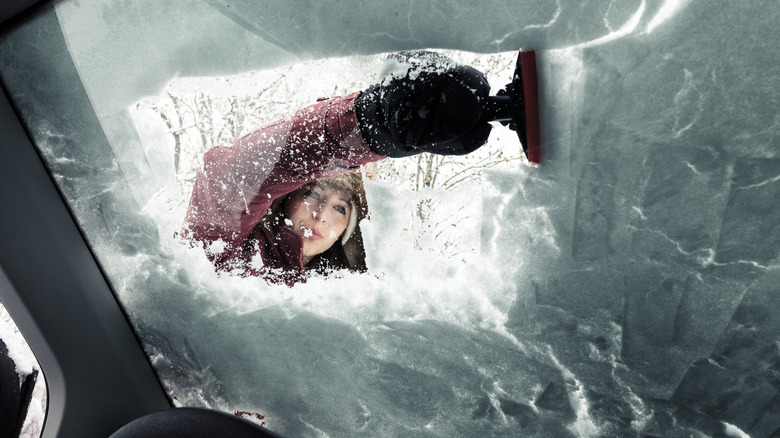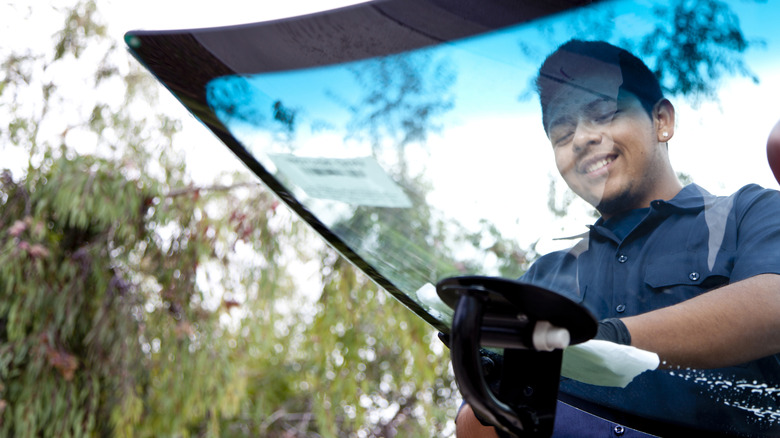Can Your Car's Windshield Crack In Cold Weather?
We may receive a commission on purchases made from links.
It's hard to believe, but the first cars developed didn't include a windshield. While these first attempts at an automobile weren't capable of high speeds, the lack of protection from road debris required drivers and passengers to wear goggles to shield their eyes. When the very first windshield was introduced in 1904, the concept of laminated glass hadn't yet been invented. This meant that in the event of an accident, the glass could shatter, creating a hazardous situation for anyone in the vehicle.
Modern windshields don't get nearly the credit they deserve as an essential component to safe travel on today's roads. Considering how much abuse they receive from things like loose gravel, extreme temperature changes, and collisions, it's not surprising that around 30% of U.S. insurance claims have to do with windshields. There are ways to avoid chips and cracks to protect your windshield, but can a fracture in the glass be caused directly by wintry weather?
Unfortunately, if enough ice compounds near the bottom of the windshield and temperatures drop even further, the ice can expand, forcing a crack to develop. In addition, wide temperature variations, such as those present between the inside of the car and the exterior, can enable cracks to get bigger. Fortunately, there are ways to stop a cracked windshield from getting worse, and there is a relatively simple test to determine whether you can get it repaired or if it requires a complete replacement.
How to prevent winter windshield cracking
When windshields are being made, the pressure placed on the glass and plastic layers is around 800 atmospheres. In fact, if it weren't for minuscule weaknesses present in the material, a windshield would rival hardened stone in terms of resistance to flying debris. But it's not just tumbling pebbles skipping off the roadway and hitting the windshield that is of concern; it's temperature as well.
To keep the freezing weather from fracturing your windshield, take an extra few minutes to thoroughly remove snow from the base of the glass with a snow brush. Often, especially when in a rush to get to work, people simply brush away just enough snow to see out in front of the car. But, if you allow slush and snow to pile up on the bottom of the windshield, there is a chance it could crack your glass if it freezes.
If you do notice ice accumulating on your windshield, parking in a garage will help melt the frozen material. However, not everyone can pull their vehicle into a garage, so the next best option would be covered parking, which would prevent snow from gathering on top of your car. If even covered parking spaces aren't available, you could use a product like the EcoNour Windshield Cover for Ice and Snow, which will protect your glass during inclement winter weather.
When does a crack necessitate a new windshield?
If you do notice a crack on your windshield, there is a test used to determine if it can be repaired or if a new one is required. According to AAA, a crack can generally be fixed if it's smaller than a dollar bill. However, it's crucial to act immediately following the discovery of any windshield damage, as winter temperatures can wreak havoc on your car's glass, causing the fracture to get larger if not addressed quickly.
Repairs can range between $80 to $150 and depend on a few factors, such as your insurance policy and home state. In the worst-case scenario, a crack is too large, and you'll need a brand-new windshield, which can run an average of up to $550. Some of the latest technology, such as rain-sensing wipers and driver assistance systems, will raise the replacement costs because the technology will need to be recalibrated once a new windshield is installed. How long it takes to replace a windshield is also dependent on a few important elements that can increase the overall installation time.


